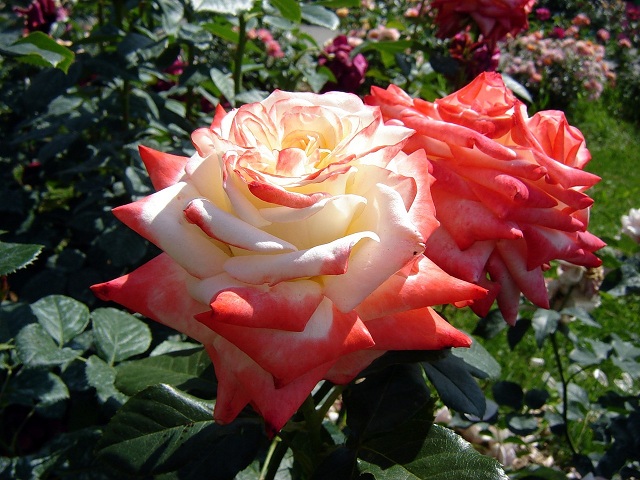Content:
Svitness hybrid tea rose variety (also called Ecuador) is quite in demand among gardeners. These flowers are not only great for garden decoration, but will also look amazing in a cut bouquet.
History
Rose Sweetness (English "sweetness") looks like a confection. When you look at it, you get the impression that the flower is made of sweet culinary mastic, painted by an experienced pastry chef around the edge in a rich raspberry color.
The variety was bred at the end of the 19th century in Germany on the basis of a tea and park remontant roses. The variety was developed by breeder Gaito from the Tantau nursery.
Characteristics of the variety
The glass-shaped flower includes 60 cream-colored velvet wavy petals with cherry-scarlet edging. The plant has a branched and erect stem. It is quite long - from 80 to 100 cm. There are almost no thorns on it. Sweetness foliage sweetness of a deep green color with a matte sheen, forms a dense mass on the bush.
The bud is fragile, opens rather slowly and forms a fairly large, about ten centimeters, flower. It can be single or adjacent to several (usually 3-5) lateral buds.
Sweetness rose aroma is very elegant and pronounced. The garden in which the rose sweet is planted is filled with a subtle fragrance. The culture blooms especially abundantly during the month. This usually occurs between late June and late July.
Sweetie rose is a re-blooming variety that allows you to admire stunningly beautiful flowers that uniquely combine red and white colors throughout the summer and fall.
It is highly recommended to buy culture seedlings in specialized nurseries. Instances with a closed root system should be selected. They tolerate transportation much better and quickly take root in a new place.
If, for some reason, you have to purchase seedlings with an open root system, you should pay particular attention to the roots. They must be healthy and well developed. If the root system looks dried, it is strongly recommended to keep the culture in water for a day before planting it in the ground.
As the description of the Sweetness variety testifies, the rose propagates exclusively by grafting. When looking at a seedling, the graft site can be seen. For those plants that are planted in containers, it will be impossible to see the grafting site, since it will be covered with earth.
Features of agricultural technology
For planting, you will need to dig holes, the diameter of which can vary from 30 to 50 cm.The distance between the planted bushes should be from 50 to 70 centimeters. The seedlings should be placed in such a way that the grafting site is located on average a couple of centimeters below the surface of the ground.
It is enough to water the culture once a week. In the spring and autumn, it is enough to carry out the procedure twice a month.The soil should not be allowed to dry out under any circumstances. Dry soil can cause a crop to lose its varietal characteristics.
As for feeding, mineral and organic fertilizers are required for the shrub throughout the growing season. The first fertilizer is applied to the soil in the spring. In this case, any nitrogen compounds (for example, urea) are best suited. After three weeks, the soil will need to be enriched with potassium-phosphorus fertilizer.
Practice shows that the Sweetness variety reacts best to a manure mixture. For its manufacture, cow dung and water are used in a ratio of 1: 3. It will not be superfluous to add some potassium sulfate and superphosphate to the mixture.
Sweetness roses respond well to sudden temperature changes. But the culture is able to survive the relatively harsh winter of central Russia only if a reliable shelter is organized. You should start hiding the plant with the onset of stable low temperatures. Spruce branches are usually used as a covering material. Additionally, you can sprinkle shrubs inclined to the ground with earth or peat.
Advantages and disadvantages
Among the advantages of the variety, it should be noted, first of all, the following points:
- elegant flower appearance;
- long flowering period;
- sufficiently high resistance to cold;
- ease of care.
There are also some disadvantages:
- weak resistance to fungi;
- almost instant negative reaction to a lack of light and cold watering;
- poor rain tolerance.
Sweetness roses can be used both as one of the elements of landscape design and for a cut bouquet.














